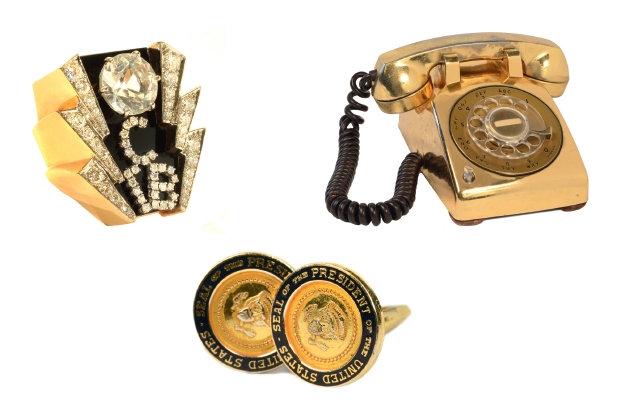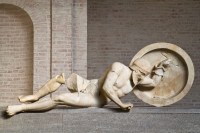In the giftshop at the new Elvis exhibition at the Dome, you can buy your own version of his flared white jumpsuits. I can’t think of anyone who could wear one and not look ridiculous — particularly if they had a bit of a weight problem. But Elvis, who would have turned 80 this year, managed to pull it off.
This selection of the best Elvisiana from Graceland is full of the sort of kitschy excess that would sit so awkwardly on anyone else: his outsized solitaire diamond ring, the gold phone by his bedside table, the Harley-Davidson golf carts he used to rocket through Graceland’s grounds.
It’s easy to mock the schlock — and who could feel quite at ease in Graceland’s Jungle Room, with its green shag carpet, faux-fur armchairs and waterfall wall, fringed with fake vegetation? But it’s also easy to forget that Elvis died at Graceland in 1977; that the house, and his final, enduring image, were frozen in the 1970s, the decade that style forgot.
Nineteen seventy-seven was the year Mike Leigh’s tragicomic television play Abigail’s Party was first broadcast. As fans of the play will know, a semi-detached house in suburban London in 1977 hardly looked tasteful. What can you expect of the interiors belonging to the biggest rock star in the world, if they’ve been unchanged for 40 years?
You only have to look at the touching childhood exhibits in the show to see where all the excess — and the self-destructive, final madness — came from. Elvis was born in 1935 into dirt-poor poverty in a tiny two-bedroom shack in Tupelo, a nondescript city in the Mississippi boondocks. His father, Vernon Presley, went to jail for forging a cheque. When he did earn money, it was in short supply — his tax return for 1943, on display in the show, records a $12.56 tax payment that year.
Elvis’s parents were real document hoarders. Graceland’s director of archives, Angie Marchese, says that that grew out of their poverty. If the police are on your case, you quickly need to produce evidence you paid this tax demand, that overdue bill. They also kept little Elvis’s Crayola crayons and his school reports. His eighth-grade report for 1947–1948, at Gloster Street Junior High School in Tupelo, records top grades in courtesy for six terms in a row. Now you understand those charming old southern manners he still displayed at the tragic end: all those ‘Thank you, sirs’ and ‘Thank you, ma’ams’. You can also understand the excess that brought on the tragedy. Take a polite boy from a remote corner of Mississippi, and confer untold talent, beauty and riches on him. Which of us wouldn’t go mad?
Even in the excess, there is a bravura style borne of the confidence produced by genius. One of the jumpsuits on show — from the 1973 Aloha from Hawaii concert — is a quite staggering piece of full-throttle Americana. Made by his costume designer Bill Belew, it’s decorated with lots of little American bald eagles, wearing stars-and-stripes waistcoats. Another three huge eagles, in red, white and blue jewels, are, literally, spreadeagled across the front and back of the suit, and the cape he wore over the whole glorious outfit.
Elvis’s staunch patriotism — like his heartfelt Christianity — is another wellspring of his originality. Rebellious rock stars aren’t supposed to send letters to President Nixon like the one on show that reads: ‘I admire you and have great respect for your office… The drug culture, the hippie elements, the Students for a Democratic Society, Black Panthers, etc. do not consider me as their enemy or as they call it the establishment. I call it America and I love it.’ There is unintentional comedy in the neighbouring exhibit: the Bureau of Narcotics and Dangerous Drugs badge Nixon gave Elvis. Of the 347 exhibits in this show about Elvis’s life, this is the only one that refers, unwittingly, to the pharmaceuticals that caused his death.
Even if you’re not an Elvis fan, he is a great chunk of 20th-century American cultural history. He is at the crossroads of white, black, city, country, national, international, rich and poor. He casts light on old world southern politeness; northern rudeness about rednecks; southern Baptist Christianity; the still extreme southern race divide; and the patriotism of Middle America, untarnished by the cynicism of Britain, Europe and the American coasts.
Even in his overconsumption of food, money and clothes, Elvis was ahead of the curve for the gadget-obsessed, pleasure-loving, fat modern western world. Elvis has left the building; his legacy hasn’t.






Comments